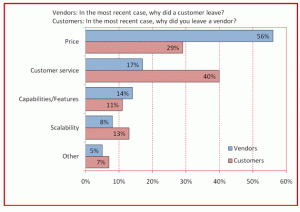Stop Believing What Your Customers Tell You
A recent article on Marketing Sherpa demonstrated the difference between what companies (vendors) believe are the reasons customers leave, and the real reasons customers leave. While companies cite pricing as the top reason, customers say they really leave because of customer service.
Why the Difference?
The article sights two great reasons for this difference. First, since it’s usually sales reps that report the loss, it’s easier to report price as the issue since it’s beyond their control. Second, it’s easier for customers to claim price as the issue as it’s harder to dispute and doesn’t cast blame on sales.
Divorce and Customer Loss
I can’t find the exact study, but when asked why a couple is divorcing, an often cited reason is financial stress. When researchers dove deeper with the individuals to get to the real reason for the divorce it’s usually not financial. It’s just that it’s easier to say that, it’s less embarrassing than stating infidelity or abuse as the reason. Same thing is happening here. It’s just easier to use price as the excuse.
It’s hard for a customer to tell you straight-up that it is poor service that pushed them to leave. It’s hard because that kind of information may lead to confrontation, defensiveness, or hurt feelings with the sales rep. These are all experiences the customer doesn’t want to pile on top of their existing frustration with your company.
More Proof
As a customer researcher, I am often able to show companies that their beliefs around customer loss are just not real. By conducting customer satisfaction interviews in the B2B space I have often showed clients that service and support were significant issues for clients. It can come as a shock since the company previously believed they had no problem with their sales and support staff.
In working with credit unions and member (customer) loss, you will find that many members will cite “moved out of area” as a primary reason for leaving the credit union. Now I know the housing crunch is brutal, but there really are not that many people moving out of the service area of the credit union. It’s just easier to give that reason when you are face-to-face with the teller when you go in to close your account.
Good News, Bad News
As the article states, the good news is that customers are less likely to leave because of price. Also, excellent customer service can lead to stronger customer loyalty and a price premium for your company. The bad news – if you don’t really know what your customers think of your customer service you may be headed for a trial separation or a divorce…
Filed under: Credit Unions, Customer Feedback, Customer Loyalty, Customer Service, Voice of the Customer | Leave a comment »








